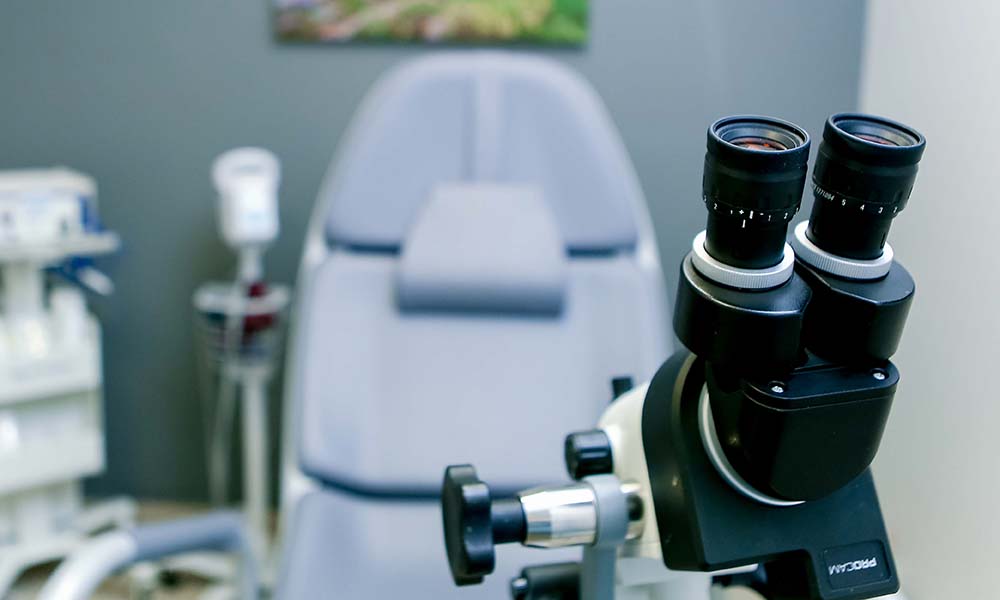


The biopsies taken of your cervix will tell us whether you have a low-grade or high-grade lesion, where “lesion” means “abnormality”. Women who have a high-grade lesion (moderately or severely precancerous cells, otherwise known as CIN 2 or 3) usually need a treatment called a Large Loop Excision of the Transformation Zone (LLETZ), which is also known as Loop Excision and Electrocautery Procedure (LEEP). This is, in most instances, safely performed under local anaesthesia in our colposcopy unit, avoiding the expense and risks associated with a procedure in theatre under general anaesthesia.
We use special wire loops, through which electrical current is passed, to cleanly remove that area on the cervix, called the squamocolumnar junction, where HPV infects and from where precancerous and cancerous lesions of the cervix commonly arise.
The tissue that is removed is submitted to the laboratory for analysis, confirming exactly how severe the abnormality is and whether it has been completely removed (i.e. are the margins of the piece of tissue clear of precancerous cells).
We then cauterise the area of the cervix where the piece of tissue has been removed to minimise significant bleeding from the coin-sized raw area on the cervix that remains, as well as to destroy any remaining precancerous cells.
This area needs to be thought of as a scab in the vagina. This thinking explains why we advise that no tampons are used, and no penetrative sexual activity occurs for 6 weeks. Heavy exercise and bathing should also be avoided for 2 weeks.
It is normal to have vaginal bleeding on and off for 6 weeks, but it should never be heavier than your usual period. Around 7 to 10 days after the procedure, the ever-shrinking scab will come off the cervix, and this may lead to slightly more intense bleeding for a day. It is also possible that you will hardly bleed from the procedure. The larger the piece of tissue that has been removed, the more bleeding there is likely to be.
We will contact you within a week to give you your results from the removed piece of tissue. We seldom ask you to return to the unit for a re-LLETZ after a few weeks. This would only happen if the margins of the removed piece of tissue are obviously involved with a significant precancer, and we feel a bigger piece of tissue needs to be removed.
We usually provide antibiotics for a week after the procedure to diminish this risk. Please advise us if you have any allergies to antibiotics. Make sure to avoid alcohol during the antibiotic course in order to avoid unpleasant side effects.
While we take care to manage this risk during the procedure, occasionally, bleeding can be heavier than a period. This requires you to contact us, where we will most likely ask you to return to the colposcopy unit to have a look at the cervix and stop whatever bleeding we may find on examination.
This means a shortening of the cervix by an LLETZ/LEEP procedure, which can lead to preterm labour and birth or even late miscarriages in the second trimester. This risk is greater the larger the piece of tissue that needs to be removed and if you have had more than one LLETZ/LEEP.
The absolute risk of this complication is low. Most women who need an LLETZ/LEEP deliver their babies at term, but it is a severe complication, which is why we prefer not to overtreat the cervix of a young woman who has not completed her family when there is only a low-grade or mild lesion present. These can be safely monitored until childbearing is complete, when a decision may be made to treat the cervix for persistent disease.
It is also imperative to know that the length of the cervix can be measured in future pregnancies after an LLETZ/LEEP by performing an ultrasound examination. Suppose the cervix is found to be short initially or shortens significantly from one ultrasound to the next. In that case, there are means available to us to prolong these pregnancies, which include the use of a hormone called progesterone to relax the uterus and even a minor surgery done in the second trimester where a stitch called a “cerclage” is placed in the cervix to keep it long and closed for as long as possible, decreasing the risk of severely preterm births.
While complications from the LLETZ/LEEP procedure are always undesirable, they can be justified against the risk of leaving a severe precancer untreated, ultimately leading to invasive cervical cancer.